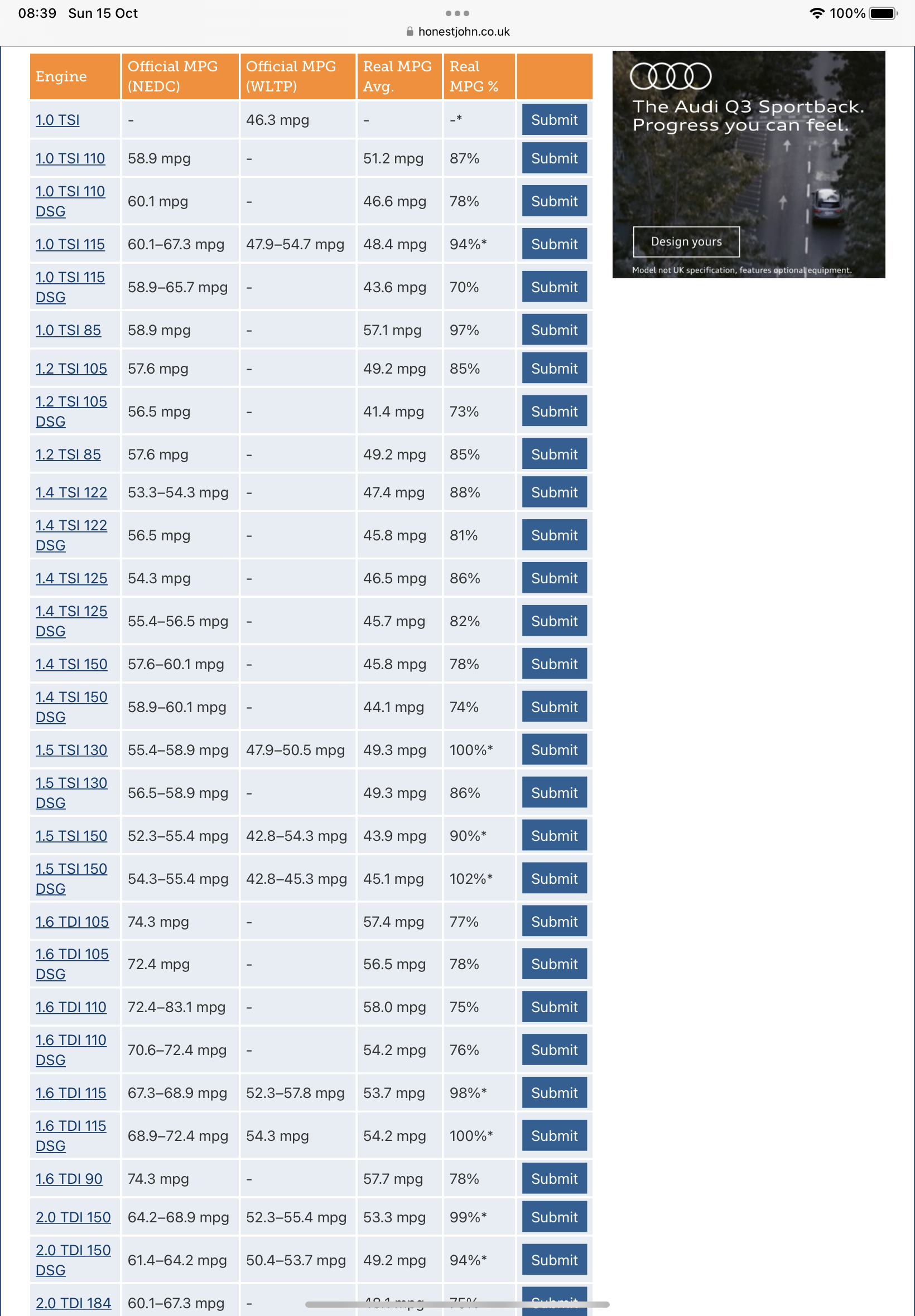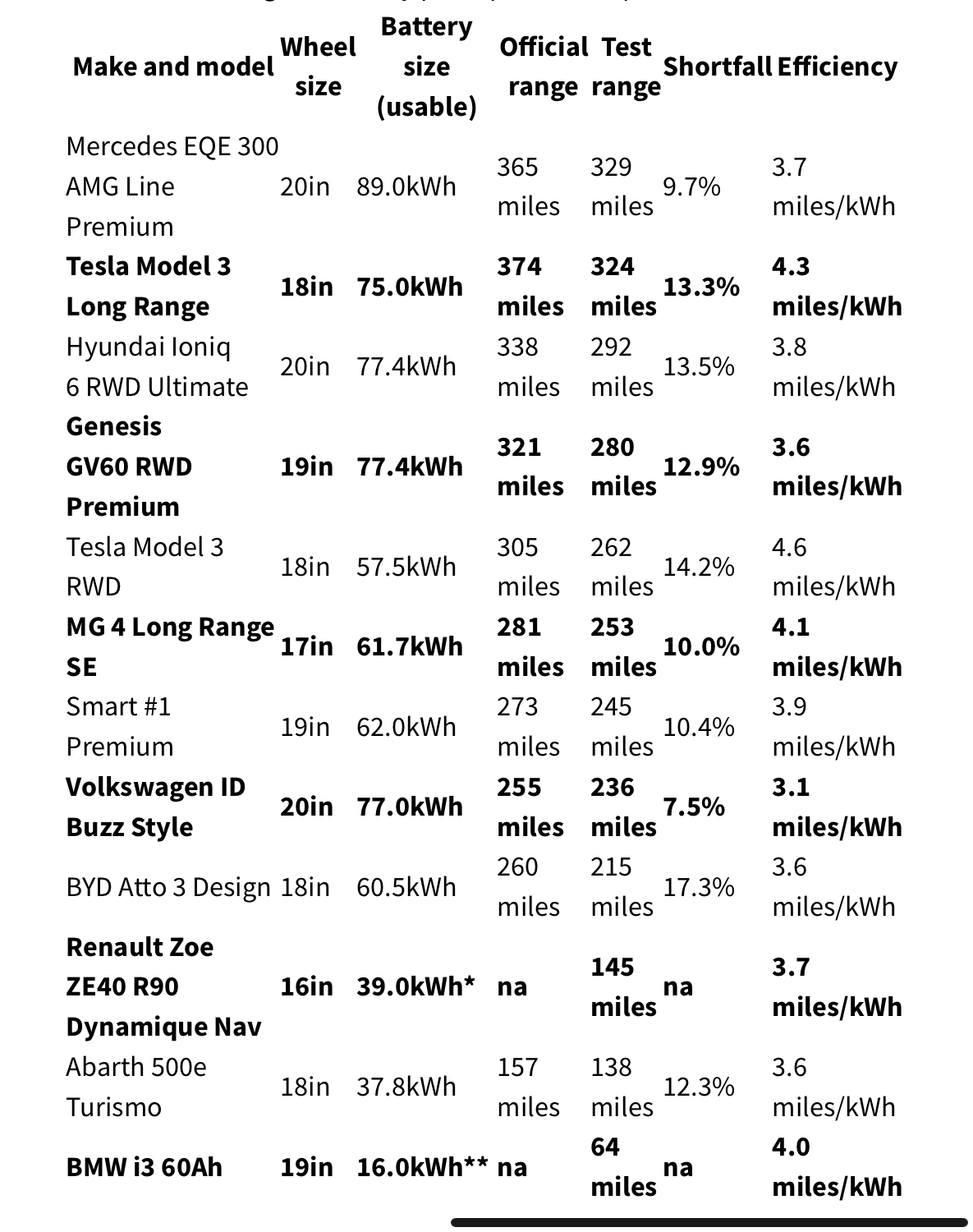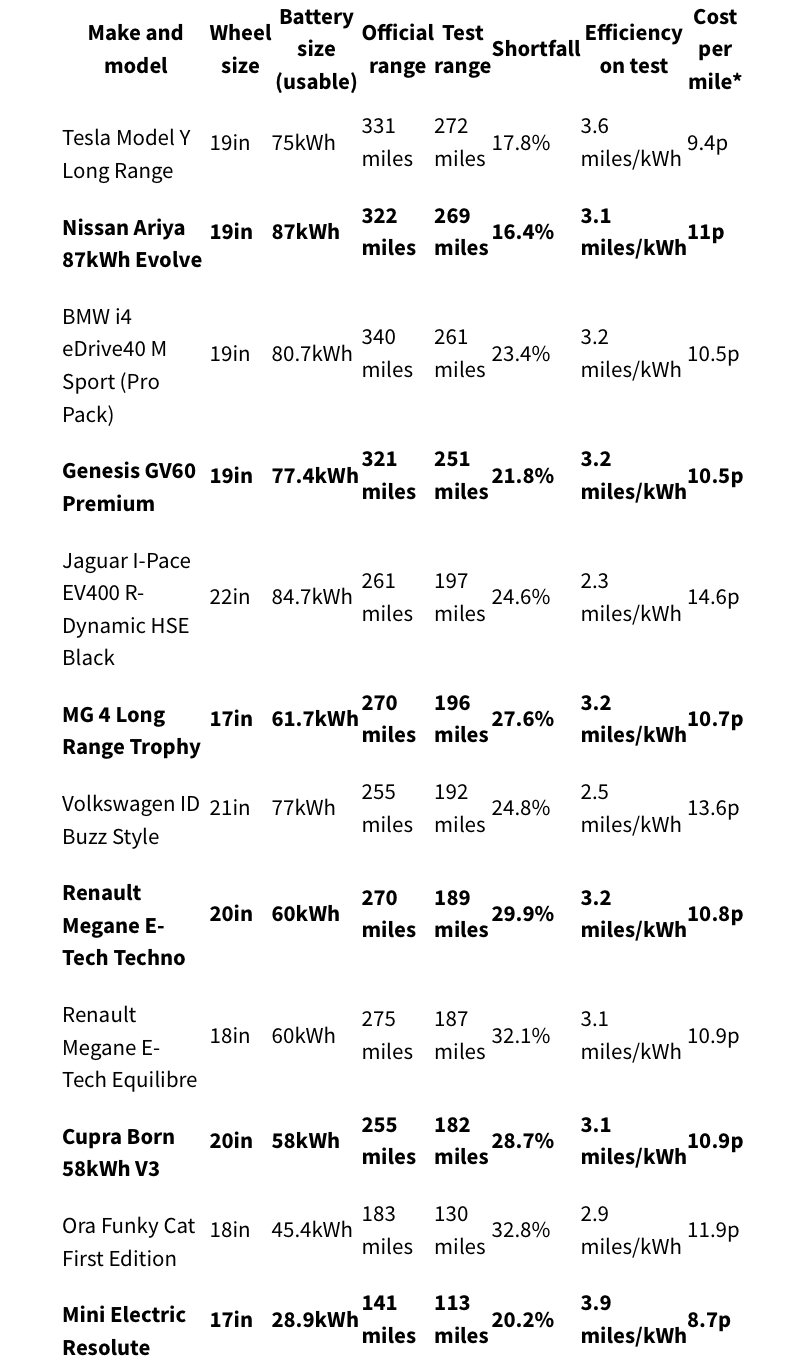We’d like to remind Forumites to please avoid political debate on the Forum.
This is to keep it a safe and useful space for MoneySaving discussions. Threads that are – or become – political in nature may be removed in line with the Forum’s rules. Thank you for your understanding.
📨 Have you signed up to the Forum's new Email Digest yet? Get a selection of trending threads sent straight to your inbox daily, weekly or monthly!
EV Discussion thread
Comments
-
You won't get the range if you drive like a beep.0
-
So does that mean an ICE car can be returned for real world fuel consumption compared to test / brochure data used in the marketing?JKenH said:First cases of Consumer Duty used to return EVs on range grounds
I am not sure that the rules are correct or intended to be applied in the way set out in that article that was linked, but if that is how the rules apply, the rules should apply in an equal way to ICE cars, not just EVs.
0 -
The WLTP testing procedure favours EVs with relatively low speeds and idealised ambient temperatures so the real world results tend to be further off than for ICE cars. My 2020 Golf consistently returns better fuel consumption than WLTP figures whereas it was quite a struggle to reach the WLTP range in my 2020 Leaf.Grumpy_chap said:
So does that mean an ICE car can be returned for real world fuel consumption compared to test / brochure data used in the marketing?JKenH said:First cases of Consumer Duty used to return EVs on range grounds
I am not sure that the rules are correct or intended to be applied in the way set out in that article that was linked, but if that is how the rules apply, the rules should apply in an equal way to ICE cars, not just EVs.The test procedure uses a temperature of 23C which is ideal for EVs and also is conducted without ancillary systems (HVAC) operating. Turning on the heating on an EV in winter can impact range in an EV whereas it won’t in a ICE car. The average speed during the test is 46.5kph (around 29 mph). EVs are very efficient at this speed compared to motorway speeds whereas ICE cars are relatively less efficient. The result is when EV drivers set about driving in real world conditions such as on motorways the range achieved falls short by a larger margin than the consumption miss on ICEVs.Northern Lincolnshire. 7.8 kWp system, (4.2 kw west facing panels , 3.6 kw east facing), Solis inverters, Solar IBoost water heater, Mitsubishi SRK35ZS-S and SRK20ZS-S Wall Mounted Inverter Heat Pumps, ex Nissan Leaf owner)0 -
It is 'horses for courses' though. When we used to have ICE vehicles our use pattern - 90% short journeys from cold at low speeds resulted in mpg way below the manufacturers claims whereas the same journeys in an EV, all year around, we get pretty much the EPA or more.JKenH said:
The WLTP testing procedure favours EVs with relatively low speeds and idealised ambient temperatures so the real world results tend to be further off than for ICE cars. My 2020 Golf consistently returns better fuel consumption than WLTP figures whereas it was quite a struggle to reach the WLTP range in my 2020 Leaf.Grumpy_chap said:
So does that mean an ICE car can be returned for real world fuel consumption compared to test / brochure data used in the marketing?JKenH said:First cases of Consumer Duty used to return EVs on range grounds
I am not sure that the rules are correct or intended to be applied in the way set out in that article that was linked, but if that is how the rules apply, the rules should apply in an equal way to ICE cars, not just EVs.The test procedure uses a temperature of 23C which is ideal for EVs and also is conducted without ancillary systems (HVAC) operating. Turning on the heating on an EV in winter can impact range in an EV whereas it won’t in a ICE car. The average speed during the test is 46.5kph (around 29 mph). EVs are very efficient at this speed compared to motorway speeds whereas ICE cars are relatively less efficient. The result is when EV drivers set about driving in real world conditions such as on motorways the range achieved falls short by a larger margin than the consumption miss on ICEVs.I think....0 -
I doubt that drivers with your usage pattern would have any issue with range so I suspect it is a small proportion of drivers using their cars for long journeys that are the ones returning them. Last winter there was a lot of chat on social media from first time EV buyers about their cars falling well short on range. Corsa Es were a particular problem and even some new Tesla owners were only getting 150 miles.michaels said:
It is 'horses for courses' though. When we used to have ICE vehicles our use pattern - 90% short journeys from cold at low speeds resulted in mpg way below the manufacturers claims whereas the same journeys in an EV, all year around, we get pretty much the EPA or more.JKenH said:
The WLTP testing procedure favours EVs with relatively low speeds and idealised ambient temperatures so the real world results tend to be further off than for ICE cars. My 2020 Golf consistently returns better fuel consumption than WLTP figures whereas it was quite a struggle to reach the WLTP range in my 2020 Leaf.Grumpy_chap said:
So does that mean an ICE car can be returned for real world fuel consumption compared to test / brochure data used in the marketing?JKenH said:First cases of Consumer Duty used to return EVs on range grounds
I am not sure that the rules are correct or intended to be applied in the way set out in that article that was linked, but if that is how the rules apply, the rules should apply in an equal way to ICE cars, not just EVs.The test procedure uses a temperature of 23C which is ideal for EVs and also is conducted without ancillary systems (HVAC) operating. Turning on the heating on an EV in winter can impact range in an EV whereas it won’t in a ICE car. The average speed during the test is 46.5kph (around 29 mph). EVs are very efficient at this speed compared to motorway speeds whereas ICE cars are relatively less efficient. The result is when EV drivers set about driving in real world conditions such as on motorways the range achieved falls short by a larger margin than the consumption miss on ICEVs.Some ICE drivers will get poor mpg in urban use (particularly with pre WLTP cars) but perhaps are accustomed to that from past experience so don’t complain. It will sink in with EV drivers eventually but range is such a big part of EV marketing at the moment that some people might feel duped. Remember these are lease cars. People perhaps don’t bond with them the same as when owned so don’t accept their foibles so easily.Maybe the cost of living crisis has something to do with it and people are just looking for excuses to get out of their expensive leases.I think the big issue though is that if your EV doesn’t have sufficient range for your lifestyle its impact is much more telling than simply having to put a bit more petrol in the car.Whatever the cause/logic leasing companies are reporting it so it is happening.
Edit: I just typed in Volkswagen Golf WLTP mpg into Google and found this comparison of real world and WLTP mpg for the Golf. While the old NEDC figures flattered the Golf’s mpg it seems WLTP mpg figures are much more realistic. I have just checked the Tesla UK website and the WLTP range for the standard range model is quoted at 305 miles. I am sure some drivers will have achieved that but I believe the consensus is that the real world range is closer to 260 mpg.
I have just checked the Tesla UK website and the WLTP range for the standard range model is quoted at 305 miles. I am sure some drivers will have achieved that but I believe the consensus is that the real world range is closer to 260 mpg.
WhatCar did a range test in summer and these are the results. Edit 2: This summer weather test from WhatCar? Reports a real world range of 262 miles for the Model 3 which they calculate as 4.6mpk.
Edit 2: This summer weather test from WhatCar? Reports a real world range of 262 miles for the Model 3 which they calculate as 4.6mpk.
https://www.whatcar.com/news/range-test-how-far-can-electric-cars-really-go/n24836
WhatCar? also did a winter EV range test but didn’t use the same cars so no comparative figures for the TM3 although they did test the TMY. Whereas the typical shortfall in range in summer might be 10-15% in winter it is closer to 20-30% on average. It is important to note that in these tests the cars are driven on a private test track until they stop - not something one would want to do on the road and so realistically, perhaps, 10miles or so needs to be deducted from the WhatCar? figures in real life.Northern Lincolnshire. 7.8 kWp system, (4.2 kw west facing panels , 3.6 kw east facing), Solis inverters, Solar IBoost water heater, Mitsubishi SRK35ZS-S and SRK20ZS-S Wall Mounted Inverter Heat Pumps, ex Nissan Leaf owner)0
It is important to note that in these tests the cars are driven on a private test track until they stop - not something one would want to do on the road and so realistically, perhaps, 10miles or so needs to be deducted from the WhatCar? figures in real life.Northern Lincolnshire. 7.8 kWp system, (4.2 kw west facing panels , 3.6 kw east facing), Solis inverters, Solar IBoost water heater, Mitsubishi SRK35ZS-S and SRK20ZS-S Wall Mounted Inverter Heat Pumps, ex Nissan Leaf owner)0 -
People need to understand that an EV doesn't have a 'range'; there's the hypothetical maximum range from which you will lose miles as energy is lost to a number of factors*. These include air resistance, water displacement, cabin heat and braking friction (amongst others). Basically the faster you go, the worse the weather and the more you change speed, the lower your actual range will be.
I've seen real world range of between 130 and 260 miles from my (standard range) MG5 with the average being around 200 miles. An important caveat is that the types of journey where range is actually important tend to be faster and therefore less efficient. However, with thoughtful route planning and reducing top speeds, I've actually achieved comparatively good efficiency on longer journeys.
*Of course fossil vehicles are subject to similar losses, but they also have other losses (relating to thermal efficiency and engine revs) which make the EV's losses more obvious and have a more significant effect on 'range'.
Essentially EVs are way more efficient and use far less energy overall so any variable losses are logically going to be a higher proportion of that total energy. While EVs can mitigate losses by driving slower and using less cabin heat, fossil vehicles are less efficient at lower speeds and have plenty of waste heat to keep you warm. The fossil vehicle's trick is to simply carry (and mostly waste) vastly more energy.
1 -
My "standard journey" is a 12 mile (or 15 if I come back the pretty way) round trip to the Spar shop. In my petrol car I would aim for 50mpg which I could easily achieve in summer but not in winter. I expect my EV to be much the same; 4.5m/kWh in summer but a bit less in winter. Even ay winter performance to EV fuel cost per mile is many times less than the summer performance of the ICE vehicle.1
-
This, or words to the same effect, have been mentioned at various times by various posters.Petriix said:An important caveat is that the types of journey where range is actually important tend to be faster and therefore less efficient.
Obviously, there are the rules of physics so driving faster uses more energy than driving slower by a square rule relative to speed.
However, anecdotally, I find the best journey miles / kWh has been achieved on longer journeys. I put this down to the motorway speed being offset by:- Less time proportionately in "conditioning" battery and environment from cold to operating state
- Less time in traffic, where environment is being maintained, radio is in use, lights / wipers, etc but no mileage
- Maintaining constant speed, once up to speed, is less energy intensive than regular changes of speed (up or down)
0 -
I don’t think there is any doubt that fuel cost in an EV will be cheaper, summer or winter, provided that one can charge at home. It’s not a EV vs ICE argument. The issue with the lease returns is that the range is not matching up to expectations on long trips. The TM3, while one of the better cars according to WhatCar?, is still likely to deliver less than the advertised (WLTP) figure in other than slow speed driving.ICE cars can also be less efficient than WLTP but WhatCar? testing suggests the miss is closer to 6.5% - less than half the summer shortfall for EVs and around a quarter of the winter shortfall. It isn’t the comparison with ICE cars that is the problem though. While, for EV drivers doing local trips, range may not be an issue, for many it is absolutely crucial to their choice of car (whether buying or leasing). If the car can’t do the range they want it may cause considerable inconvenience. Manufacturers are obliged to use WLTP figures in their advertising (although they can also quote a lower real range figure if they want or give an urban and a motorway figure rather than just the combined). All the real world tests show that WLTP EV range is difficult to achieve driving the car as one might an ICE car and that is what is causing the dissatisfaction; the WLTP figure for EVs is a poor representation of reality. Experienced EV drivers know this and adjust their expectations accordingly but new EV drivers who have not been following the subject may be unaware and end up disappointed. As was suggested on the other EV thread, EPA figures, as used in the USA, would give a better guide to actual consumption but even then, in winter, the figures are optimistic.
EV Fleet World, two years ago, highlighted this issue and now the problem is coming home to roost. https://evfleetworld.co.uk/manufacturers-exaggerating-ev-range-claims-by-up-to-30-says-fleet-evolution/
While they may be great for selling EVs to those who haven’t done their research, WLTP figures which overstate range can do more harm than good. They cause dissatisfaction and a lack of trust with customers and provide more ammunition for those who don’t like EVs.
Northern Lincolnshire. 7.8 kWp system, (4.2 kw west facing panels , 3.6 kw east facing), Solis inverters, Solar IBoost water heater, Mitsubishi SRK35ZS-S and SRK20ZS-S Wall Mounted Inverter Heat Pumps, ex Nissan Leaf owner)1 -
I agree that WLTP 'range' is misleading. The overriding message needs to be that 'real world range' is highly variable depending on how you spend the available energy. I do also think that people need to learn to drive more efficiently.0
Confirm your email address to Create Threads and Reply

Categories
- All Categories
- 352.8K Banking & Borrowing
- 253.9K Reduce Debt & Boost Income
- 454.7K Spending & Discounts
- 245.9K Work, Benefits & Business
- 602K Mortgages, Homes & Bills
- 177.8K Life & Family
- 259.8K Travel & Transport
- 1.5M Hobbies & Leisure
- 16K Discuss & Feedback
- 37.7K Read-Only Boards



